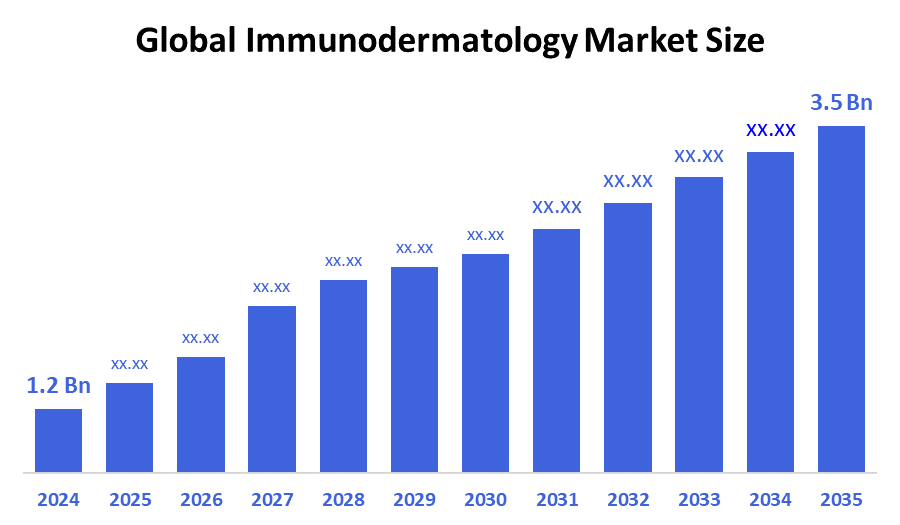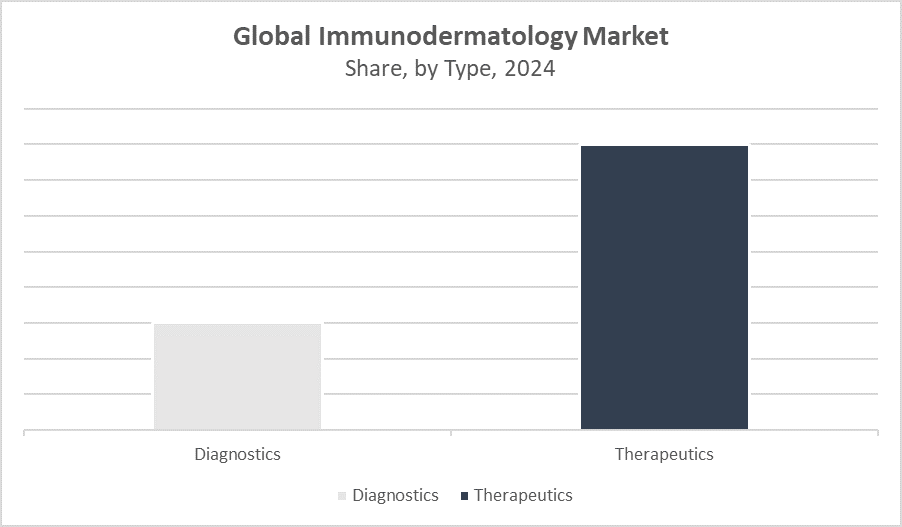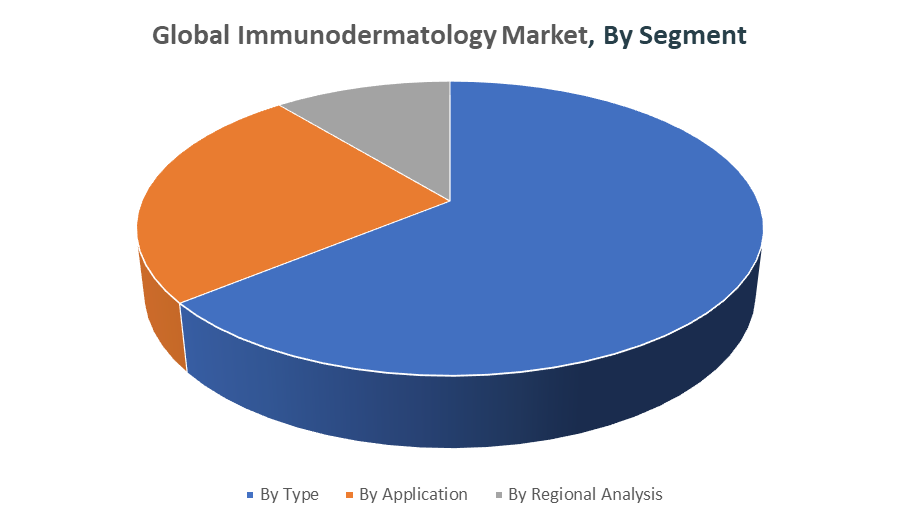Global Immunodermatology Market
Global Immunodermatology Market Size, Share, and COVID-19 Impact Analysis, Impact of Tariff and Trade War Analysis, By Type (Diagnostics, Therapeutics, and Others), By Application (Psoriasis, Atopic Dermatitis, Pemphigus, and Others), and By Region (North America, Europe, Asia-Pacific, Latin America, Middle East, and Africa), Analysis and Forecast 2025 - 2035
Report Overview
Table of Contents
Immunodermatology Market Summary, Size & Emerging Trends
According to Spherical Insights, the Global Immunodermatology Market Size is Expected to Grow from USD 1.2 Billion in 2024 to USD 3.5 Billion by 2035, at a CAGR of 10.1% during the forecast period 2025-2035. Rising prevalence of autoimmune skin disorders and increasing awareness about advanced diagnostic and therapeutic techniques are key factors driving market growth. Additionally, ongoing research and development in biologics and personalized medicine support the expanding immunodermatology landscape.

Key Market Insights
- North America is projected to hold the largest market share in the immunodermatology market during the forecast period.
- Therapeutics dominated the market share in 2024 due to the growing adoption of biologic treatments.
- Psoriasis accounted for the largest application segment revenue share globally.
Global Market Forecast and Revenue Outlook
- 2024 Market Size: USD 1.2 Billion
- 2035 Projected Market Size: USD 3.5 Billion
- CAGR (2025-2035): 10.1%
- North America: Largest market in 2024
- Asia Pacific: Fastest growing market
Immunodermatology Market
The immunodermatology market focuses on diagnosing and treating immune-related skin conditions such as psoriasis, atopic dermatitis, and pemphigus. It encompasses advanced diagnostic tools and innovative therapies, especially biologics, which precisely target immune system pathways to reduce inflammation and autoimmune responses. The rising prevalence of autoimmune skin disorders worldwide, coupled with increasing patient awareness, is driving market demand. Additionally, growing healthcare spending, supportive reimbursement policies, and significant investments in research and development are fueling continuous innovation and broader availability of effective treatments. Personalized medicine is becoming a crucial trend, enabling tailored therapies that improve patient outcomes. Emerging biologic treatments provide new options for managing challenging skin diseases, contributing to market growth. Overall, the combination of technological advancements, expanding patient populations, and increased healthcare infrastructure is propelling the global immunodermatology market forward.
Immunodermatology Market Trends
- Growing adoption of biologic therapies targeting specific immune responses.
- Increasing focus on personalized medicine in dermatology treatments.
- Expansion of diagnostic platforms using molecular and genetic technologies.
Immunodermatology Market Dynamics
Driving Factors: Rising prevalence of autoimmune skin disorders and advancements in biologic therapies
The immunodermatology market is primarily driven by the growing incidence of autoimmune skin disorders like psoriasis and atopic dermatitis worldwide. Advances in biologic therapies, which specifically target immune system pathways, have significantly improved treatment effectiveness and patient quality of life. Increased public awareness and improved diagnostic methods are enabling earlier disease detection, further fueling market growth. Supportive healthcare policies, alongside rising investments in research and development, are accelerating innovation and accessibility of advanced treatments. Collectively, these factors contribute to robust demand and expansion of the immunodermatology market globally.
Restrain Factors: High treatment costs and regulatory challenges
Despite promising growth, the high costs of biologic treatments limit patient access, especially in emerging and price-sensitive markets. Complex and lengthy regulatory approval processes further delay the introduction of new therapies. Additionally, reimbursement policies in many regions are restrictive, reducing affordability and adoption rates. Concerns about the long-term safety and side effects of biologic drugs also contribute to cautious usage. These financial and regulatory barriers hamper widespread market penetration and slow overall expansion of immunodermatology therapies.
Opportunity: Personalized medicine and emerging markets
Personalized medicine offers significant opportunities by enabling tailored immunodermatology treatments that improve efficacy and reduce side effects. Advances in molecular diagnostics support this approach by identifying specific biomarkers for targeted therapy. Emerging markets, with growing healthcare infrastructure and increasing patient populations, present substantial untapped potential. These regions are witnessing rising awareness and demand for advanced treatments. Innovations in biologics and diagnostics in these markets are expected to drive future growth, expanding access and offering novel solutions for immune-mediated skin disorders.
Challenges: Market competition and patent expirations
The immunodermatology market faces strong competition from alternative therapies, biosimilars, and generic drugs, which often provide lower-cost options. Patent expirations of major biologic drugs increase competition, reducing revenue for original manufacturers. To maintain market share, companies must invest heavily in innovation, differentiating their products through efficacy and safety improvements. Additionally, patient responses to treatments vary widely, creating a need for continual development of new therapeutics. These challenges require strategic R&D and marketing efforts to sustain long-term growth in a competitive and evolving landscape.
Global Immunodermatology Market Ecosystem Analysis
The global immunodermatology market ecosystem comprises pharmaceutical manufacturers, healthcare providers, research institutions, distributors, and regulatory authorities. Collaboration among these players fosters innovation, ensures adherence to medical and safety standards, and enhances patient care. Strategic partnerships and significant investments in research and development are essential for driving advancements in therapies and diagnostics. Together, these stakeholders support market growth by addressing evolving healthcare needs and improving treatment outcomes for immune-mediated skin diseases worldwide.
Global Immunodermatology Market, By Type
What factors enabled the therapeutics segment to dominate the immunodermatology market in 2024?
The therapeutics segment dominated the immunodermatology market in 2024, capturing approximately 65% of the total revenue share due to the increasing prevalence of autoimmune and inflammatory skin disorders requiring targeted treatment. Innovations in biologics and advanced immunomodulatory therapies have significantly improved patient outcomes, driving demand for therapeutic solutions. Furthermore, growing awareness among healthcare providers and patients about the effectiveness of these treatments, combined with expanding healthcare infrastructure, contributed to the segment’s strong market position.

Why did the diagnostics segment hold approximately 30% of the immunodermatology market share in 2024?
The diagnostics segment accounted for about 30% of the immunodermatology market share in 2024, driven by the growing need for accurate and early detection of autoimmune and inflammatory skin diseases. Advances in diagnostic technologies, such as biomarker identification and molecular testing, enhanced the precision and speed of diagnosis. Increasing awareness among healthcare professionals about the importance of early diagnosis and personalized treatment plans further fueled demand. These factors combined to help the diagnostics segment secure a significant portion of the market.
Global Immunodermatology Market, By Application
How did psoriasis gain a competitive edge in the immunodermatology market in 2024?
Psoriasis led the immunodermatology market in 2024, holding approximately 40% of the revenue share due to its high prevalence and chronic nature, which requires long-term management and treatment. Advances in targeted therapies, especially biologics, have significantly improved patient outcomes, increasing treatment adoption rates. Growing awareness of psoriasis as a serious immune-mediated disease and increasing investment in research and development further contributed to its dominant position in the market.
What made atopic dermatitis a significant segment in the immunodermatology market in 2024?
Atopic dermatitis accounted for roughly 25% of the immunodermatology market in 2024 due to its widespread prevalence and chronic nature, which necessitates ongoing treatment and management. Advances in targeted therapies, including biologics and novel immunomodulators, have improved patient outcomes and increased treatment adoption. Furthermore, rising awareness among healthcare providers and patients about the disease’s impact and the importance of early intervention contributed to its significant market share.
North America dominated the global immunodermatology market, accounting for around 38% of the total revenue.
This leadership is due to advanced healthcare infrastructure, high awareness of autoimmune skin disorders, and widespread adoption of biologic therapies. Strong government support, favorable reimbursement policies, and ongoing research investments further bolster market growth in this region.
The United States is the largest country-level market, contributing nearly 22% of the global revenue.
Its established healthcare system, numerous pharmaceutical companies focusing on immunodermatology, and extensive clinical research activities drive significant market expansion. High patient awareness and access to cutting-edge treatments support continued growth.
Asia Pacific is the fastest-growing region, with a projected CAGR of about 11.2%.
Rising healthcare expenditure, increasing prevalence of autoimmune skin diseases, and expanding access to medical care fuel this growth. Growing awareness and government initiatives in emerging markets further accelerate adoption.
WORLDWIDE TOP KEY PLAYERS IN THE IMMUNODERMATOLOGY MARKET INCLUDE
- AbbVie Inc.
- Novartis AG
- Pfizer Inc.
- Johnson & Johnson
- Eli Lilly and Company
- Sanofi S.A.
- Bristol-Myers Squibb Company
- Amgen Inc.
- Regeneron Pharmaceuticals, Inc.
- Biogen Inc.
- Others
Product Launches in Immunodermatology Market
- In February 2025, AbbVie Inc. introduced a new biologic therapy in North America designed to treat moderate to severe psoriasis. This innovative treatment offers enhanced efficacy and a better safety profile compared to existing options. The launch is anticipated to reinforce AbbVie’s position as a leader in the immunodermatology therapeutics market by providing patients with a more effective and safer solution for managing psoriasis.
Market Segment
This study forecasts revenue at global, regional, and country levels from 2020 to 2035. Decision Advisors has segmented the immunodermatology market based on the below-mentioned segments:

Global Immunodermatology Market, By Type
- Therapeutics
- Diagnostics
- Others
Global Immunodermatology Market, By Application
- Psoriasis
- Atopic Dermatitis
- Pemphigus
- Others
Global Immunodermatology Market, By Regional Analysis
- North America
- US
- Canada
- Mexico
- Europe
- Germany
- UK
- France
- Italy
- Spain
- Russia
- Rest of Europe
- Asia Pacific
- China
- Japan
- India
- South Korea
- Australia
- Rest of Asia Pacific
- South America
- Brazil
- Argentina
- Rest of South America
- Middle East & Africa
- UAE
- Saudi Arabia
- Qatar
- South Africa
- Rest of the Middle East & Africa
FAQs
Q: Which segment dominated the immunodermatology market by type in 2024?
A: The therapeutics segment dominated the market with approximately 65% of the revenue share due to increasing adoption of biologic therapies.
Q: Which application segment holds the largest share in the immunodermatology market?
A: Psoriasis accounted for the largest application segment with about 40% of the market revenue in 2024.
Q: What are the key drivers for the immunodermatology market?
A: Rising prevalence of autoimmune skin disorders, advances in biologic therapies, and increasing awareness about early diagnosis are major market drivers.
Q: What restrains the growth of the immunodermatology market?
A: High treatment costs, regulatory hurdles, and limited reimbursement options restrict market expansion, especially in emerging economies.
Q: What opportunities exist in the immunodermatology market?
A: Personalized medicine approaches, emerging markets, and innovations in molecular diagnostics offer significant growth opportunities.
Q: Who are the leading companies in the global immunodermatology market?
A: Key players include AbbVie Inc., Novartis AG, Pfizer Inc., Johnson & Johnson, Eli Lilly and Company, and Sanofi S.A.
Q: Are there any recent product launches in the immunodermatology market?
A: Yes. AbbVie Inc. launched a new biologic therapy for moderate to severe psoriasis in February 2025, enhancing its market position.
Q: How does the immunodermatology market ecosystem operate?
A: The ecosystem comprises pharmaceutical companies, healthcare providers, research bodies, distributors, and regulators collaborating to innovate and maintain quality standards.
Q: What are the latest trends in the immunodermatology market?
A: Increasing use of biologics, focus on personalized treatments, and advancements in molecular diagnostic technologies are key trends shaping the market.
Check Licence
Choose the plan that fits you best: Single User, Multi-User, or Enterprise solutions tailored for your needs.
We Have You Covered
- 24/7 Analyst Support
- Clients Across the Globe
- Tailored Insights
- Technology Tracking
- Competitive Intelligence
- Custom Research
- Syndicated Market Studies
- Market Overview
- Market Segmentation
- Growth Drivers
- Market Opportunities
- Regulatory Insights
- Innovation & Sustainability
Report Details
| Pages | 240 |
| Delivery | PDF & Excel via Email |
| Language | English |
| Release | Sep 2025 |
| Access | Download from this page |
